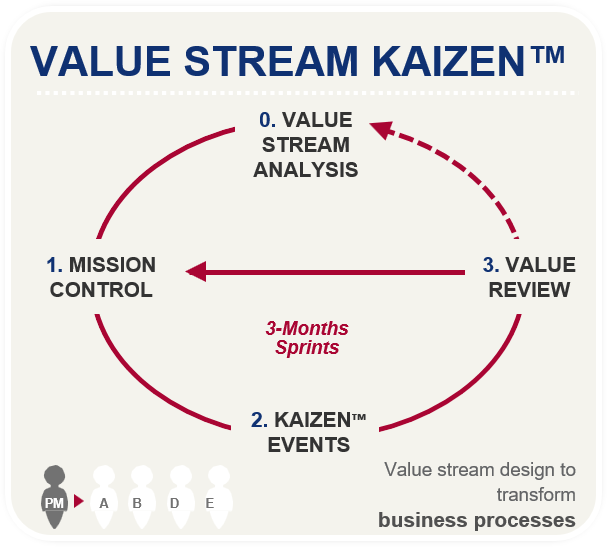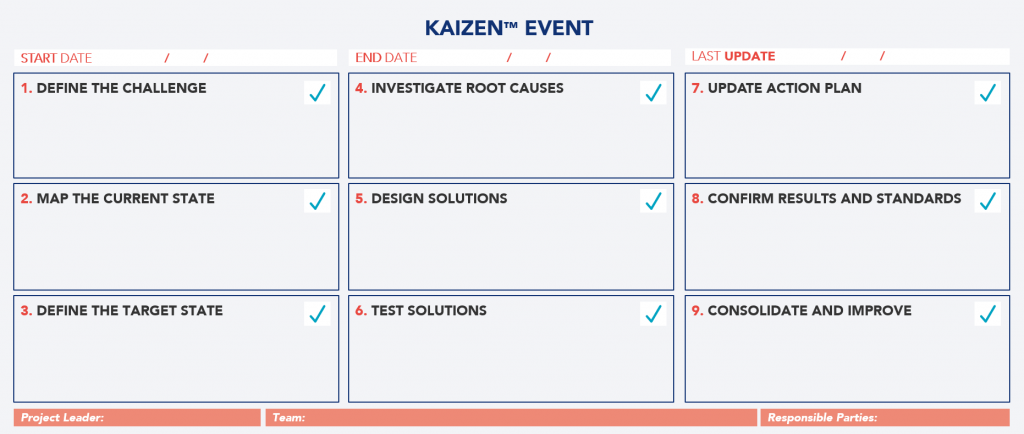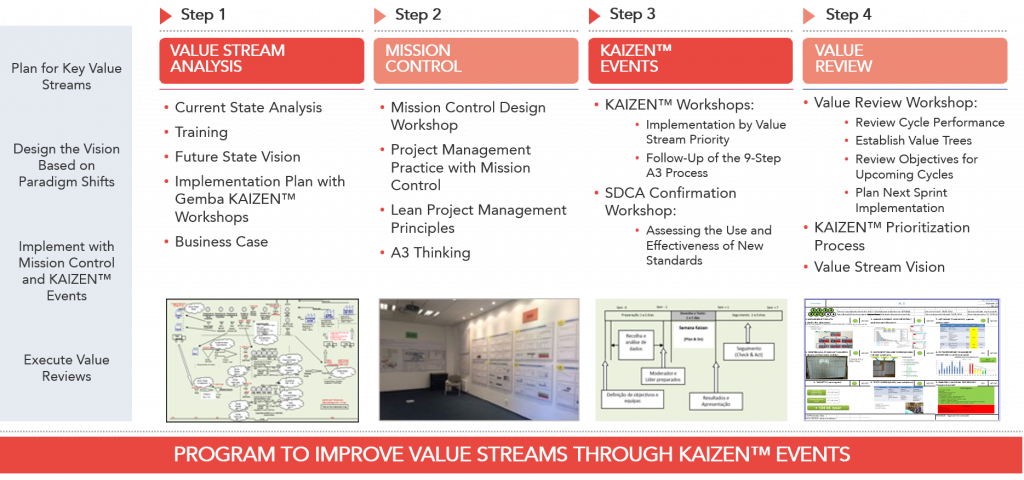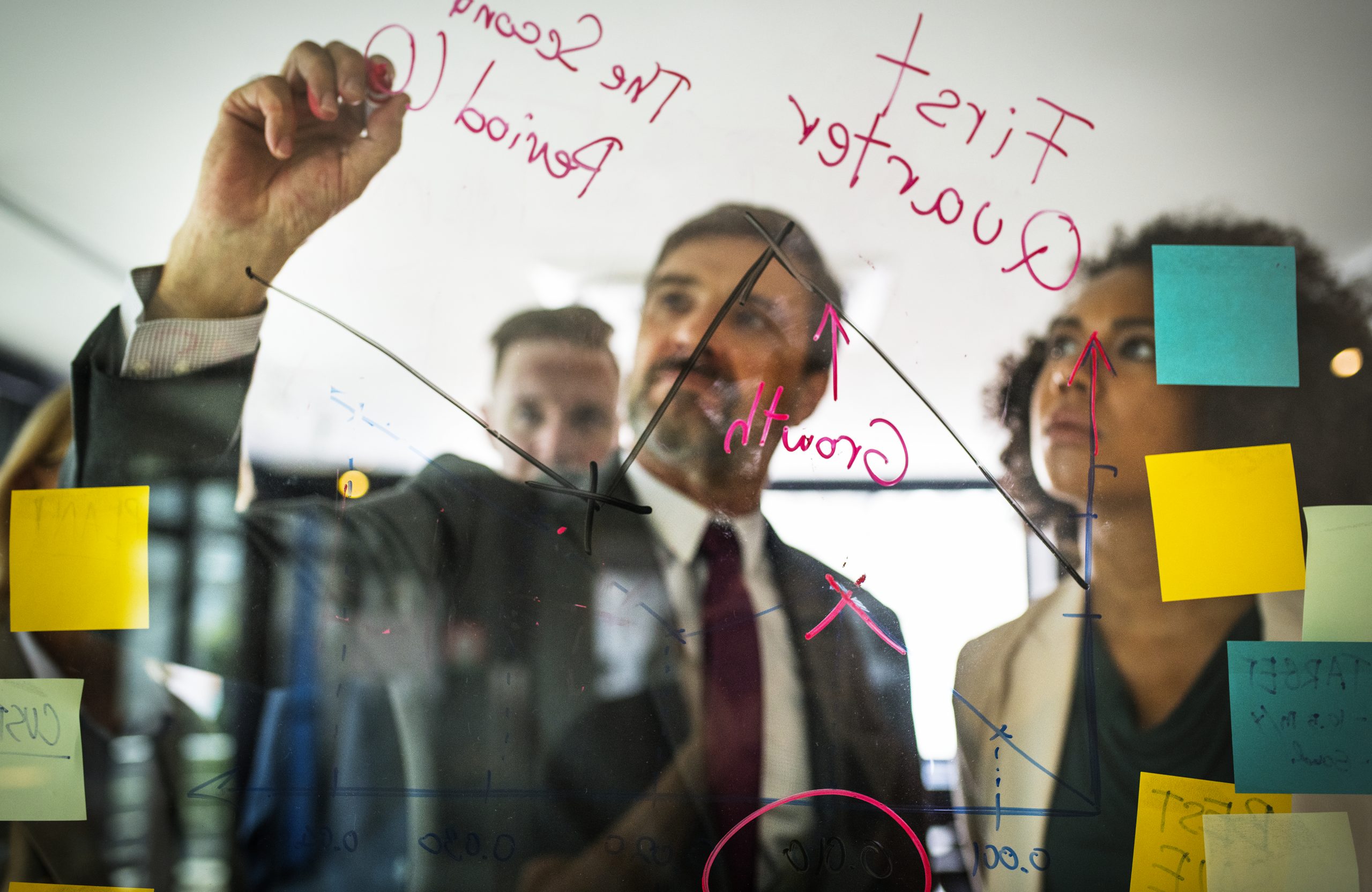KAIZEN™️ Events are key elements of organizational transformation journeys. They are an effective way to organize project teams to solve a challenging problem or implement an innovative solution for an existing need. These intensive workshops bring together multidisciplinary teams to develop solutions and implement practical and measurable improvements. In this article, we will explore in detail what KAIZEN™️ Events are, how to implement them, and what benefits to expect from this transformative approach.
What is a KAIZEN™️ Event?
Focused on the organization’s need for improvement, a KAIZEN™️ Event is an intensive workshop typically divided into three phases:
1. Preparation
In this phase, relevant data is collected, and necessary equipment and materials are prepared. It is essential to clearly understand the process or area that will be targeted for improvement.
2. Implementation
The team designs and tests solutions for improving the identified process/area. The work is carried out according to standardized KAIZEN™️ methodologies.
3. Follow-Up
After implementation, the results are monitored, and any deviations are corrected. It is essential to track the results and assess the financial impact of the improvements made.
When executing a KAIZEN™️ Event, there is a set of golden rules that have to be followed to ensure its effectiveness:
1. Multidisciplinary Teamwork
A KAIZEN™️ Event should involve a multidisciplinary team, with representatives from different areas and different skill sets. This promotes a comprehensive and diversified approach to problem-solving and improvement roll-out.
2. Alignment and Focus on a Single Topic
All team members must be aligned and focused on a single matter during the event. This ensures a clear direction and avoids distractions that could compromise the results.
3. Quantified Objectives
The objectives of the KAIZEN™️ Event should be measurable. Setting specific goals allows the team to track progress and evaluate the impact of the improvements.
4. Defined Duration (Intensive Days)
A KAIZEN™️ Event should have a well-defined duration, usually over intensive days. This focused approach allows the team to fully dedicate themselves to deploying improvements, accelerating the change process.
5. Preparation Work
Before the KAIZEN™️ Event, carrying out adequate preparation work is key. This can involve either data collection or preparing materials and equipment for the workshop days.
6. Activities at the GEMBA
During the event, activities must be carried out at the Gemba – the place where the real work is done – allowing the team to observe and better understand the process and identify opportunities for improvement.
7. Immediate Implementation
The improvements identified during the KAIZEN™️ Event should be implemented right away. The rapid deployment of solutions prevents delays and ensures the benefits are obtained as soon as possible.
8. Standard Methodology (KAIZEN™️ Tools)
The KAIZEN™️ Event should follow a standard methodology, using tested and proven KAIZEN™️ tools. These tools help the team analyze problems, identify solutions, and implement improvements in a structured and efficient manner.
9. Application of Countermeasures for Rapid Deviations Correction
Whenever deviations in performance indicators are detected, immediate countermeasures should be applied to correct them.
10. Tracking Results and Calculating Financial Impact
In the follow-up of KAIZEN™️ Events, it is necessary to track the results of the implemented improvements and calculate their financial impact. This allows the organization to evaluate the workshop’s success and decide on replicating the implemented solution in other areas.
Unfortunately, many organizations fail to implement the improvements they plan. The way KAIZEN™️ Events are structured allows teams to stay focused on action, enabling quick and effective improvement implementation. A KAIZEN™️ Event is described by several expressions that capture its unique essence and approach:
1. Learn by Doing
This expression suggests that the team should test and do for itself. The best way to learn is to start doing autonomously;
2. Go to Gemba
This expression underlines the importance of going to the Gemba, where value is added, and all opportunities for improvement can be identified. Attend the Gemba to get the team’s full involvement in carrying out the actions;
3. MUDA Eyes
The team should always be focused on identifying MUDA (waste) to eliminate it;
4. Focus on Doing, Not Just Planning
Workshops should be for more than just planning actions – implementing them at the Gemba is the point. All preparation work should be done before the event day.
Who Should Participate in a KAIZEN™️ Event?
A KAIZEN™️ Event should involve a multidisciplinary team composed of members from different areas and different reporting levels. This includes operators, supervisors, managers, technical experts, or anyone directly involved in the process or area that will be the target for improvement. The leaders of the natural teams, and the management levels, should be leading these KAIZEN™️ Events. The participation of all involved is essential to obtain different perspectives and ensure that all stakeholders are heard.
How Long Does a KAIZEN™️ Event Typically Last?
The intensive days of a KAIZEN™️ Event typically last a week. During this period, the team intensely dedicates itself to the event activities, focusing on analysis, solution design, testing, and implementation of improvements. KAIZEN™️ Events are usually organized in 3-month sprints.
The rule of 1 event for every ten people per year is usually used when deciding the number of events. A company with 100 employees should hold about ten events annually. Practicing is the best way to master the process and make continuous improvements.
Where Should a KAIZEN™️ Event Take Place?
A KAIZEN™️ event should occur at the Gemba, the actual workplace where value is added. In this environment, the process or area needing improvement occurs. Conducting the event at the Gemba allows the team to directly observe the process in operation and identify MUDA, problems, and opportunities for improvement. In this way, participants can gain a complete understanding of the context and implement effective solutions.
When Should a KAIZEN™️ Event Occur?
The timing for conducting a KAIZEN™️ event can vary depending on the needs and circumstances of the organization. However, they are typically planned during Value Stream Analysis (VSA) workshops. In these workshops, an implementation plan is drawn up and includes the events to be conducted and their scheduling. KAIZEN™️ workshops can also originate from other types of activities, but this is usually the most significant.

How is a KAIZEN™️ Event Structured?
Within the universe of KAIZEN™️ events, we can find a wide variety of types, from more transversal workshops, such as 5S or standardization, to more specific workshops, such as layout and line design, standard work, SMED, supermarkets, Mizusumashi, Kobetsu Kaizen, auto-quality, new product development, website optimization, and value selling. Within the KAIZEN™️ and Lean Six Sigma methodologies, there is a wide range of tools available.
Although each of these workshops has specific methodologies with clearly defined stages, it is interesting to note that all can be summarized in one essential tool: the A3.
The 9-step A3 is a tool used to structure and track KAIZEN™️ Events. The term “A3” refers to the paper size used to document and communicate relevant information about the workshop. The sheet of paper is used to create a concise report that follows a 9-step structure. The nine steps of the A3 provide a systematic structure for addressing problems and improvements logically and comprehensively. Its use helps to promote team collaboration, clear communication, and standardization of the workshop follow-up process.

1. Define The Challenge
In the first step of the A3, we identify the business problem, who it is relevant to, and the reason behind the improvement need. Ensuring the topic is relevant to the organization’s objectives is essential. The problem to be solved should be clearly described, and for this, the 5 whys method can be used:
- What is the problem? (What?)
- Why is it a problem? (Why?)
- Where is the problem located? (Where?)
- When did it become a problem? (When?)
- Who is it a problem for? (Who?)
- What is the impact of the problem? (How much?)
In addition, it is essential to investigate previous attempts to solve the problem.
2. Map The Current Situation
In this second step, it is necessary to describe the current situation. Tools such as Value Stream Mapping (VSM) or Supplier, Input, Process, Output, Customer (SIPOC) can be used. The current situation should be presented clearly, logically, and visually. Opportunities for improvement from the starting point should be identified, speaking with data and quantifying current performance.
3. Define Target State
In the third step, a specific goal must be defined using SMART objectives (Specific, Measurable, Achievable, Relevant, Time-bound). Describe the objectives qualitatively and quantitatively and establish criteria for measuring and evaluating them. It is important to ensure that the goal is clear, measurable, and one step closer to the target state.
4. Find Root Causes
In this step, the reason for the problem or need should be investigated. Identify all possible causes as much as possible. Conduct research and use techniques such as the 5 Whys and Ishikawa diagram (fishbone). The aim is to find the root causes and explain deviations from the target state, ensuring the analysis is understandable and addresses all relevant causes.
5. Design Solutions
In this fifth step, all possible solutions are identified to achieve the desired results. Then, the solution or tool that will likely bring the best results is selected. Ranking solutions using tools such as the effort and impact matrix can aid in determining which ones to implement. When choosing a countermeasure, consider solutions that were successful in similar previous situations.
6. Test Solutions
During this stage, the impact of the proposed countermeasures and solutions is evaluated. Trials or tests must be conducted to confirm that the solution works and generates the expected results. It is also relevant to anticipate possible resistances that may arise during the implementation of the solutions. Evaluating the impact, obtaining concrete results, and ensuring the solutions’ feasibility are essential to determine whether it is appropriate to proceed with the implementation or if additional changes are needed.
7. Update Action Plan
At this stage, it is important to define the implementation plan and update the action plan. The plan should answer the following questions: who will be responsible for each action, what needs to be done, when and where the activities will be carried out, and how they will be executed. It is also necessary to consider that potential problems may arise during implementation and how to deal with resistance in advance.
8. Confirm Results and Standards
In the eighth step, the results obtained are analyzed, and verification needs to be performed to check if the objective defined in step 3 was achieved and is sustainable over time. With the “goal line” represented, trend charts can be used to monitor results according to the agreed frequency. It is vital to collect data regularly to check the effects of the countermeasures and ensure that they work as expected. The sustainment of the final solution should be done through standardization. When the results are validated, ensure that there are standards that allow the stability of the new processes and that people are trained to apply them.
9. Consolidate & Improve
In this last step, the lessons learned throughout the process need to be identified. It is also necessary to anticipate follow-up issues and ensure continuous improvement. Ultimately, improvements to be applied in the next cycle should be planned. Communicating the results of the KAIZEN™️ event and positive marketing can be used to motivate teams.
The Impact and Benefits of KAIZEN™️ Events
A KAIZEN™️ event necessarily delivers results, as it implements a new and better work method. The entire team is aligned and focused on a goal, following a structured methodology to achieve it.
KAIZEN™️ events can generate impact and bring benefits to various indicators. We can group these benefits into five main categories: quality, cost, service (delivery), team motivation, and growth.
For example, in a just-in-time flow creation event, the results achieved are usually:
- 30% productivity gain
- Quality improvement by 50%
- 40% space reduction
- Stock reduction by 70%
The impact and benefits vary according to the workshop.
1. Quality Improvement
One of the potential benefits of KAIZEN™️ events is quality improvement. By improving, standardizing processes, and solving problems at the root, KAIZEN™️ events can significantly impact the quality of products or services. This results in a reduction of non-quality costs, a decrease in complaints, an increase in customer satisfaction, and, consequently, an increase in loyalty.
2. Cost Reduction
A large part of KAIZEN™️ events aims to reduce costs and eliminate process waste. This can be achieved through stock reduction, space release, operational efficiency, productivity improvement, and reduction of non-quality costs, among other possibilities. The improvements implemented in KAIZEN™️ events can lead to a significant decrease in operating costs and an increase in the organization’s profits.
3. Delivery Improvement
Some KAIZEN™️ events focus on reducing processes’ lead time (customer response time). This results in faster delivery of products or services to customers, greater flexibility to meet their needs, and reduced waiting time. Improving service and lead time can give the organization a competitive advantage, increasing customer satisfaction and brand loyalty.
4. Increased Team Motivation
KAIZEN™️ events involve employees in designing and implementing improvements and optimizing their daily work. This creates a collaborative work environment where everyone is encouraged to contribute to ideas and solutions to improve processes. Involvement in KAIZEN™️ events can increase team motivation, enhance internal communication, promote teamwork, and strengthen the relationship with the organization.
5. Business Growth
KAIZEN™️ events can also propel organizational growth. KAIZEN™️ events in areas such as marketing and sales often directly impact sales positively. Another area where these events also impact business growth is R&D. Growth can occur through entering new markets or expanding in current markets, developing new products/services, or increasing productive capacity.
These five categories encompass the key benefits organizations can achieve by implementing successful KAIZEN™️ events. It’s important to emphasize that these categories are not mutually exclusive and often overlap, resulting in comprehensive benefits for the organization.
How to Start Implementing KAIZEN™️ Events in Your Organization?
The selected KAIZEN™️ events should follow a structured process, as when conducted ad-hoc, they may not align with the organization’s actual priorities and, consequently, may not reach their full potential. KAIZEN™️ activities in an organization typically begin with an event called Value Stream Analysis, in which a priority value stream is selected to be worked on. During this phase, the current state is analyzed, the future state is designed, and a deployment plan is established with the KAIZEN™️ events to be carried out in the subsequent phase. In other words, events are selected, and priorities are set according to the improvement needs of the value stream.

How the Kaizen Institute Can Assist You on This Journey
Organizations often encounter the challenge of planning improvements but not achieving them. Teams often spend too much time thinking about what might prevent them from improving, looking for the perfect solution, and without realizing it, there are still no improvements after several months.
The Kaizen Institute has over 30 years of experience successfully implementing KAIZEN™️ events in various types of organizations worldwide.
The KAIZEN™️ method keeps teams focused on what they need to do to carry out the action plan as quickly as possible. This is the difference between planning and implementing. When leaders participate in a KAIZEN™️ event and realize that it is truly possible to implement changes so quickly, it becomes for them the only way to improve the organization and deliver effective results. KAIZEN™️ consultants act as facilitators and assist in the application of KAIZEN™️ methodologies that enable change implementation.
This new approach to implementing impactful and disruptive projects can develop KAIZEN™️ thinking in employees, reinforcing the importance of continuous improvement and, consequently, transforming the organizational culture.
Still Have Questions Related to KAIZEN™️ Events?
What is Value Stream Analysis (VSA)?
Value Stream Analysis is a KAIZEN™️ event that begins with mapping the current value chain, making all performed activities visible, to identify those representing waste or added value. This mapping includes not only the materials flow but also the information flow. Relevant data, such as labor, stocks, times, equipment data, and others, are added to this map. Then, the future state mapping phase begins, where the team is challenged to create a vision that contains only relevant activities. Subsequently, the definition of the KAIZEN™️ events to be carried out is made, and finally, the expected benefits are calculated.
What are some examples of KAIZEN™️ events and their respective objectives?
Pull Planning
Implement a planning model based on the actual demand of the customer, in which their consumption triggers the replenishment of the finished product stock.
Mizusumashi
Gather and allocate all operations that do not add value to the process, but are necessary, to one or more employees and standardize all these tasks in a repetitive logistic cycle.
WIP Inventory Supermarkets
Scale and implement systematic replenishment of work-in-progress stock by setting up supermarkets.
Just-In-Time
Implementation of a unit flow cell.
Single-Minute Exchange of Die (SMED)
Reduce setup time and series changes.
Overall Equipment Effectiveness (OEE)
Improve the overall efficiency of the equipment in terms of availability, performance, and quality.
New Product Development
Standardize and accelerate the development and industrialization of new products.
Value Analysis/Value Engineering
Improve the value of a product/component, defined by the relationship between function and cost, reducing the cost without reducing the essential functions.
Auto Quality
Implement a method to avoid receiving, making, or passing on defects or quality problems.
Problem Solving
Implement a structured approach to solve problems.
Website Optimization
Improve or develop a website to reach more potential customers and improve the user experience, providing valuable content and converting it into sales.
Value Selling
Improve the sales process, from preparation to closing, focusing on the value and benefits of a product or service for the customer.
See more on KAIZEN™️ Event
Find out more about our training program
See more on People & Culture
Find out more about improving your organization
